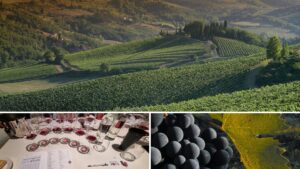Vinpro, together with the Cape Winelands District Municipality is funding a new wine tourism research pilot program to generate tourism intelligence and help South African wineries grow their Direct-to-Consumer business.
Launched in March of this year with sixteen wineries, this new pilot program is a continuation of one of Vinpro and the SA Wine Routes Forum (SAWRF)’s strategic objectives to conduct research focused on industry needs and knowledge gaps. Vinpro, and Vintelligence collaborated last year to release the SA Wine Tourism Visitor Research Report 2022 and this year the goal is smarter use of technology.
“We are extremely excited to have kicked off this amazing pilot program and we want cellars to get involved now,” says Marisah Nieuwoudt, wine tourism manager at Vinpro. “The new pilot program was launched together with Flow Networks, specialists in location analytics, proximity marketing and Guest Wi-Fi. This year we want to use the technology to our advantage to count our visitors and note where they come from, to understand the size and make-up of the total market. We want to help our wineries stay connected to wine tourists between visits, making consumer engagement in the DTC wine space possible.”
A tasting room is both the heart of the DTC sales strategy and the conversion zone for future online sales. The more data you can collect and record about customers, the better your can tailor offers and personalize communication. Flow Networks will work with the cellars involved on their marketing strategy to assist on cross-channel sales, manage their online reputation, build a loyalty and rewards program, or send offers via e-mail. Flow Networks is a reputable service provider, licensed to use Purple, and used by some of the largest brands in the world.
Presence Analytics is a software module that counts the number of mobile devices in range of a producer or cellar’s Wi-Fi router using a built-in location sensor. Visitors do not need to be connected to the farm’s Wi-Fi to be counted. It also measures the time spent in the venue and the frequency of visits.
Wi-Fi Analytics records visitors’ information that connect to a guest Wi-Fi service. A CRM record is created for each guest when they connect and is updated every time they return. This is done by linking up one or more of the farm’s existing Wi-Fi routers to the Purple Wi-Fi platform. Purple is installed on top of the existing Wi-Fi infrastructure, and setup takes less than an hour. The system can be managed via an online portal accessible to wineries. Purple instantly starts building a database via its user-friendly, custom-branded Wi-Fi landing pages once the winery goes live.
“As a region, we believe that wine tourism is not only about enjoying exquisite wines and breath-taking landscapes but also about harnessing the power of data and intelligence to support the growth of wineries and enhance our visitors’ experiences,” says Melody Botha, CEO Breedekloof Wine Valley. “That’s why we are proud to take part in the wine tourism research pilot program. By participating in this program, we aim to unlock valuable insights that can inform strategic decision-making for our wineries, enabling them to optimize their DTC business operations, improve customer engagement, and create memorable experiences for visitors. We recognize the potential of data-driven approaches to drive innovation and foster sustainable growth in the wine tourism industry.”
“We see this pilot program as an opportunity to pool our collective knowledge and expertise, so we can elevate our wine tourism offerings and position our region as a premier wine destination. We envision a future where wineries in our region can thrive in the DTC market, and where visitors can have truly exceptional wine tourism experiences,” Botha concluded.
“The tourism sector is one of the largest economic contributors in the Cape Winelands District. Between our mandated function of generating opportunities through local economic development and our role as Regional Tourism Office, this exciting and technologically advanced project ticks all the right boxes for the Cape Winelands District Municipality,” says Dr Elna von Schlicht, executive mayor of the Cape Winelands District Municipality.


![Current State of the World Vine and Wine Sector [Web Conference]](https://liz-palmer.com/wp-content/uploads/2023/04/oiv-conference.png)




